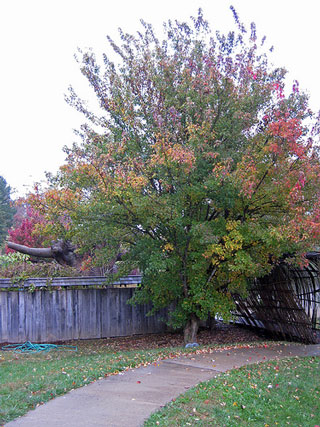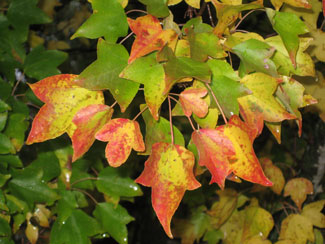Resource Library
Plant of the Week: Maple, Trident
Trident Maple
Latin: Acer buergerianum
Maple, Trident -- Trident maples are medium sized trees growing to about 30 feet tall. (Image courtesy Gerald Klingaman)
Trident maples are medium-sized, round-headed trees growing to 30 feet tall, but in their native range in eastern China can reach 90 feet. They have a tendency to be low-branched with the bark peeling off in plates and leaving behind camouflaged patches of gray, brown and orange.
Leaves are pendulous to 3 inches long with three terminal lobes. The leaf color is a rich, lustrous green in the summer that in late season turns to shades of yellow and orange. While the fall color is respectable, the tree I have observed for the past 20 years does not create the intensity of sugar maples or good red maple clones.
Flowers are yellow-green in color and of no special interest. Trident maples tend to be heavy seed producers but I have seen no sign of reseeding, perhaps because the species is said to be self-incompatible.
In China, Korea and parts of Japan the trident maple is widely used as a street tree because it tolerates air pollution well and is of moderate size. Trident maple is also a favorite for use in bonsai (Japan), penjing (Chinese) and as a patio tree in large containers. Several dozen cultivars have been named in Japan but few selections have been made here to date.
Trident maple was first described in 1865 and was introduced into Europe in 1890 and the U.S. soon thereafter. The species epitaph honors Heinrich Burger (1804? to 1858), a German who trained in the medical sciences and in 1825 was appointed by the Dutch government as assistant to the better-known Japan-based naturalist, Philipp von Siebold. David Mitchell’s The Thousand Autumns of Jacob de Zoet (Random House, 2010) gives a highly imaginative and fictionalized account of life on the manmade trading island of Dejima in Nagasaki Harbor during the early years of the 18th century.
TRIDENT FOLIAGE - Fall color for trident maples is usually late in the season and in shades of yellow and orange. (Image courtesy Gerald Klingaman)
Trident maple is a useful sized tree. At 30 feet, it fits into the smaller contemporary landscapes better than the better-known maples that often are twice as big. It grows in a wide array of soil types and tolerates drought and heat well. It is winter hardy through zone 5. Early attention to pruning to limb the tree up to maintain a single trunk will make it easier to place around patios and walkways.
By: Gerald Klingaman, retired
Retired Extension Horticulturist - Ornamentals
Extension News - November 15, 2013

